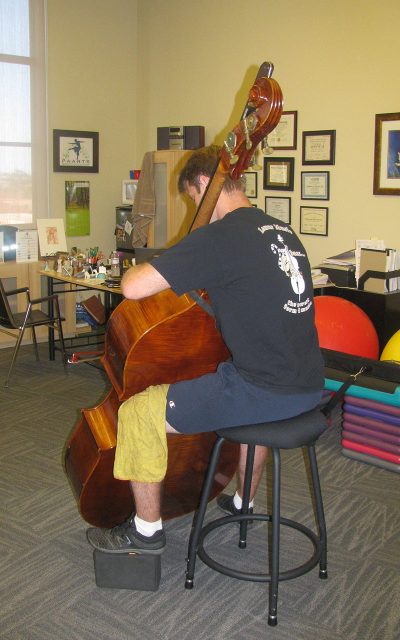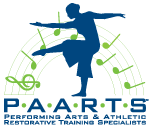“Music gives a soul to the universe, wings to the mind, flight to the imagination and life to everything” – Plato
Aren’t we fortunate to have as many musicians, instruments, and styles of music as we do across the globe. So many sounds can be made in unique and distinctive ways stimulating a multitude of feelings and sensations for the listener. This skill, and innate talent for some, can be incredibly demanding to those who pursue the art form.
 Musicians know that their work carries high physical and psychological demands – and for good reason! High volume of time spent in practice and performance; awkward playing positions; environmental hazards including smoke, noise, and drug/alcohol use are a few of the factors related to onset of injuries in the instrumental and vocal artist. In addition, each type of instrument and style of music played can lead to its own unique stresses on the body and mind: string players may develop skin dermatitis; wind and brass players may have dental stress or develop temporomandibular joint (TMJ) problems; singers may develop vocal cord issues. The stress of hitting notes and pleasing audiences – whether instrumental or vocal – goes without saying. With the majority of musicians working part time at their trade, it is not surprising that most musicians have multiple jobs in order to make ends meet which can add further stress and strain, both physically and mentally. Research informs us that around 80% of professional musicians will experience a playing related injury that takes them out of practice/performance in any given year and a staggering 70% of musicians have reported suffering from anxiety and depression.
Musicians know that their work carries high physical and psychological demands – and for good reason! High volume of time spent in practice and performance; awkward playing positions; environmental hazards including smoke, noise, and drug/alcohol use are a few of the factors related to onset of injuries in the instrumental and vocal artist. In addition, each type of instrument and style of music played can lead to its own unique stresses on the body and mind: string players may develop skin dermatitis; wind and brass players may have dental stress or develop temporomandibular joint (TMJ) problems; singers may develop vocal cord issues. The stress of hitting notes and pleasing audiences – whether instrumental or vocal – goes without saying. With the majority of musicians working part time at their trade, it is not surprising that most musicians have multiple jobs in order to make ends meet which can add further stress and strain, both physically and mentally. Research informs us that around 80% of professional musicians will experience a playing related injury that takes them out of practice/performance in any given year and a staggering 70% of musicians have reported suffering from anxiety and depression.
Musculoskeletal injuries in musicians are influenced by both intrinsic (within the person) and extrinsic (outside of the person) factors. Intrinsic factors include your: age, gender, size, strength, muscle tone, flexibility, general body conditioning, and presence of underlying disease (for example high blood pressure). Extrinsic factors include: musician playing technique (the way you hold the instrument, the forces required to play your instrument, how often you play, the positions you play in etc…), your playing posture, playing environment, rest intervals while playing, the type of music you practice/perform, how heavy your instrument is and if you have to hold it for long periods of time carry it long distances, tight playing quarters, and poor music stand placement.
So, what are some easy, general concepts that you, the active musician can consider and work into your daily routine to help avoid and alleviate some of the musculoskeletal and even anxiety symptoms you may experience? Let’s take a brief look:
Prevention Tips for Musicians:
- General conditioning: Begin to make exercise part of your daily routine. A 20-30 minute brisk walk is a great place to start. This will begin to enhance your cardiovascular system, and is also helpful in the management of stress and anxiety.
- Warm up: Get your body warm before practice and performance. This can be done in a number of ways, including walking and light calisthenics. Keep your hands warm by wearing gloves.
- Alignment: Playing in a neutral alignment will diminish stress and strain on the working body parts while you play.
- New instruments: Take time to make any necessary adjustments to your instrument – especially before playing for any extended length of time.
- Rest: Take 5-10 minute rest breaks during extended hours or practice. It is important to let the tissues have a break. During individual practice, a general recommendation is 5 mins rest every 25 minutes played. If you are working on a light piece or ensemble rehearsal, you may be able to go a little longer and then rest a little longer; again general recommendation is 10 mins rest for up to 50 minutes of slow paced or ensemble playing. Fatigue is your guide, if you begin to feel fatigued in your body, and you notice your playing accuracy diminish, it is time for a rest break.
- Stretch: When you finish playing, or even on a rest break, give a gentle stretch to those areas feeling the fatigue of sustained postures and repetitive motion. General stretching recommendations is 3 repetitions for 30 seconds.
- Daily Life: Be aware of movements in your daily life that may be contributing to your issue.e. carrying heavy objects around (gear, computer, groceries – or children), even holding your mobile phone to your ear or resting it on your shoulder adds additional strain to the upper extremity and neck. The picking up and holding of daily objects can be just enough to tip over that nagging issue into a real problem for the musician.
- Healthy Diet:As the saying goes, you are what you eat… your food is your source of fuel for playing, it also plays a significant role in tissue healing from long hours of practice and performance. A well balanced diet is necessary to support your optimum playing and recovery from playing.
- Smoking, Drugs, Alcohol: It is not new information to share that the use of cigarettes, drugs and alcohol have deleterious effects on tissue healing and mental health, including poor blood supply and circulation to tissues who need the oxygenated blood for healing and repair; and additional negative effects on sleep from having either an over stimulated or chemically depressed nervous system. At night, when you sleep is your bodies opportunity to heal and repair itself. To set yourself up for the best success (mind and body) in relationship to long hours of practice and performance, these substances are best avoided.
This list is a starting point for your self-care. If you are experiencing ongoing symptoms or would like more focused assistance in your personal musical journey as far as injury prevention, health and wellness, we offer a variety of services for instrumental and vocal musicians at PAARTS Wellness Studio. Please contact us for more information or to schedule an appointment.


